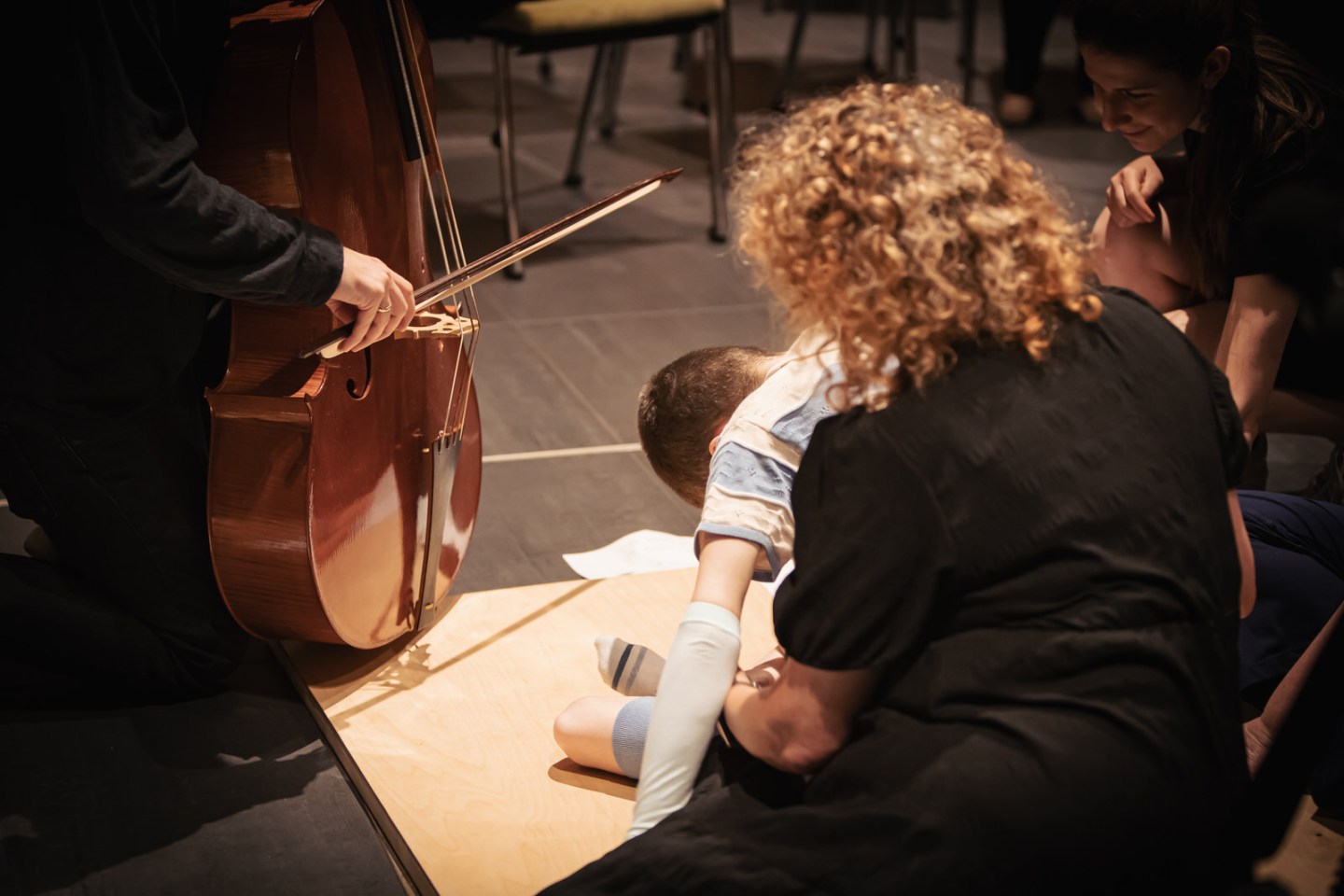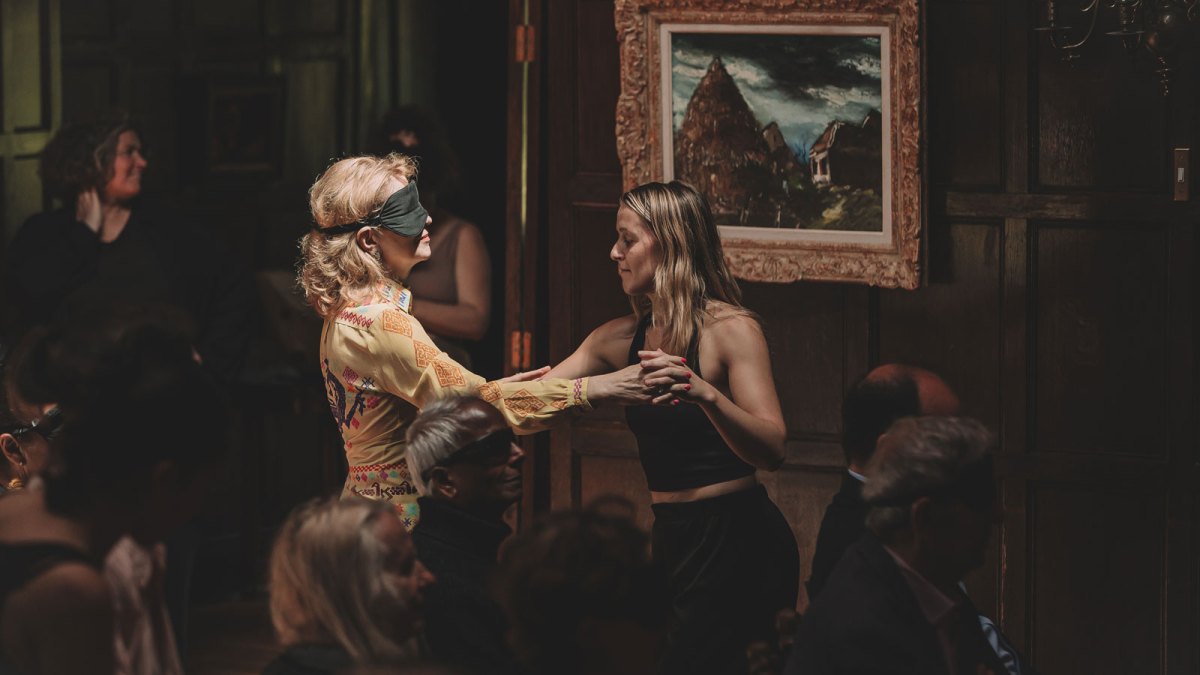In England, the summer country house opera season is winding up. Dinner jackets fly south to the dry cleaner; wicker picnic hampers bed down to hibernate until the spring.
Although there are summer opera festivals all over the world, the country house phenomenon is almost unique to the British: few other countries give such primacy to lavish black-tie picnics on lawns as manicured as the audience, where people pay princely sums to a picnic-industrial complex nurtured in stately homes, and where gastronomical and horticultural spectacle are given equal billing to the singers.
Not so at Vache Baroque, founded in 2020 by conductor and artistic director Jonathan Darboune and executive director, singer and producer Betty Makharinsky. Their summer events take place outside at The Vache, an estate near the picturesque Buckinghamshire village of Chalfont St. Giles, about half an hour outside London. On August 31, they will present Giovanni Battista Pergolesi’s late-Baroque rarity “L’Olimpiade,” directed by Laura Attridge.
It follows “Visionaries,” which took place inside the house at the end of June. Experiences of embodiment frame both productions. In “Visionaries,” blindness is turned back on the audience to reanimate their understanding of music; in “L’Olimpiade,” the athleticism of opera itself is on show.
“Visionaries” was produced by Makharinsky and Kelly O’Reilly and created in collaboration with BitterSuite, who devise guided multi-sensory concert experiences. The project presented the first part of Handel’s “L’Allegro, il Penseroso ed il Moderato,” a sort of secular cantata to words by John Milton, adapted by Charles Jennens. One of several Milton-based projects to emerge from Vache Baroque, it drew on a local connection: Milton’s cottage, where he wrote Paradise Lost, is just over the road.
The performance was preceded by an exhibition in an anteroom. Handel lost much of his sight in around 1751, and Milton was also blind by the time he wrote “Paradise Lost”; the exhibition included touch sculptures donated by Kevin Carey, former chair of the Royal National Institute of Blind People. Feeling these sculptures—some rough, others more tender and yielding—prepared the ground for what was to come: an experience of performance that entailed literal physicality. It’s an unusual kind of proximity for the concert hall, where the normal spectatorial experience is looking and listening but never touching.

Before the music began, we lined up in the entrance lobby to receive our blindfolds and a short briefing about what lay ahead. We were then eased into the performance space by BitterSuite. As the music unfolded—warring humors given voice across interlocking arias and recitatives—we were sprayed with scents, stroked, tickled, and given morsels of food. In the final number, as a carillon chimed in, “Oh let the merry bells ring round,” the blindfolds came off, and the soloists joined in a chorus, exhorting us to enjoy ourselves, at least “Till the livelong daylight fail.” The music ended in a muted half-light, as darkness—mortality—threatened to set in again.
“Visionaries” was created in collaboration with Buckinghamshire Council, partly to mark Deafblind Awareness Week 2024; the public performances were complemented by a special workshop for 20 congenitally deafblind children along with their carers and parents. Among the performers, soprano Victoria Oruwari is registered blind, and alto Sarah Denbee is visually impaired; Makharinsky received sighted-guide training from Marilyn Fisher, who trains service dogs.
It is a cliché to say that the other sensory faculties are enhanced accordingly when one is diminished. But being blindfolded for much of the performance certainly intensified aspects of the concert-going experience. The sightlessness made you try and build a picture of the room with your ear, tracing where sounds emanated: a voice high up, perhaps on a stairway or balcony; a flute or oboe far off, maybe in another room; strings on ground level, on the left. You sense, then, their movement through space, indexed against the musical structure, the ritornello seeping through the room.
Unseeing, it’s harder to draw on the energies of the public around you, or tune into the waxing and waning moods that give live performance its rhythm; conversely, the sound of stifled cough or the creak of a chair as someone shifts in their seat have a heightened impact. The music came to my ear and imagination raw, unfiltered, stripped of public reception. Added to this was a feeling of vulnerability; we were physically reliant on our guides. An unexpected brush against the arm of the person sitting next to you, the scents sprayed by the guides, or their delicate touch, were both disarming and sensual.
Even if this didn’t always feel integrated into the piece’s own logic—text and gesture seemed, at times, only obliquely intertwined—it was still a remarkable adventure outside the usual comfort zones. As spectators in the concert hall, we are normally masters of our perceptual universe. Here the dynamic was reversed.
“Not being watched while we’re performing was something incredible novel,” Darbourne told me later. “What was amazing was that the BitterSuite guides, who were leading the audience, were actually dancing the whole thing. The audience didn’t even know they were doing that. They were performing for us, so there was this triangle of experience: the audience watching us, us watching the dancers, and the dancers leading the audience.” He added, “I don’t think I’ve ever been in a creative space that has had so many axes.” An elderly gentleman, these days quite hard of hearing, approached Darbourne afterwards. “He felt like his hearing had gone back 15 years,” Darbourne recalled. “He had no visual clouding…his ears were growing more highly attuned to the space.”
Vache Baroque has taken plenty of such artistic risks, the first being getting started at all. Purcell’s “Dido and Aeneas” came in the summer of 2020 in a fog of COVID-19 restrictions and uncertainty. Even without the pandemic, performing outside in the UK is always a dicey undertaking, both acoustically and meteorologically.
In Thomas Guthrie’s production of “Dido and Aeneas” they partnered with choreographer Ukweli Roach and the hip-hop dancers of BirdGang Ltd. The dancers’ highly energized movements helped to animate an open-air theatrical space that had no wings, sets, or flies. It was the first time, Darbourne tells me, BirdGang’s artists have ever danced to a triple meter. “Our collaboration with street dance has shown us how this music interacts with human bodies. It’s so important to Baroque music, the dance—but how many musicians have ever seen it danced? To have it mirrored back to you physically…is fun!”

Other multidisciplinary collaborations followed. In 2021, they put on “Paradise and Pandemonium,” a journey through Milton’s Paradise Lost and Paradise Regained, drawing on music by J.S. and J.C. Bach (the elder) as well as Heinrich Schütz. The performance was built around Bill Woodrow’s sculpture “Self-Portrait in the Year 2082,” and featured the celebrated British actor Simon Callow as Satan. Such eclecticism reflects the estate’s own rich history of residents: one of the regicides of Charles I, a group of squatters just after the end of the Second World War, and the National Coal Board. Taken together, they suggest an ethos that is insurgent, community-oriented, and, at least in the case of the last two, down to earth.
The way Vache Baroque uses their grounds sets them apart. Less manicured and wilder than the more genteel settings of Glyndebourne or Grange Park Opera, with croquet lawns and walled gardens that are mostly pleasant backdrops for quiche and olives, Vache makes the outdoors part of the drama. In their 2022 staging of Charpentier’s “La descente d’Orphée aux enfers,” Darbourne and his team created sound installations dotted throughout, as well as a pre-show woodland performance of Giacomo Carissimi’s “Jephte,” another story with an Orphic bent. Audience members could even pay a boatman to cross the River Styx.
The latest from VAN, delivered straight to your inbox
Like “Visionaries,” the upcoming “L’Olimpiade” draws on a local connection. The Paralympic movement began in 1948 at the nearby Stoke Mandeville Hospital, when Dr. Ludwig Guttmann organized a series of games for injured former servicemen and women. In an Olympic year, Pergolesi’s 1735 opera is an apt choice. Metastasio’s text was set over 50 times, though Vivaldi’s version is the only one to receive regular performances.
The machinations of the plot are typically baroque. Against the backdrop of an Olympiad, identities are concealed and revealed, love affairs sundered, and loyalties betrayed. “It’s interesting that Metastasio’s text leaves all of the actual Olympian trials, and another couple of key dramatic moments involving physical risk or daring, offstage,” Laura Attridge tells me. “The trials or tests we are therefore invited to watch are primarily those that arise in the relationships of the characters.”
Darbourne suspects that this staging of Pergolesi’s opera is a UK first. Right or wrong, Vache Baroque has a taste for rarities. Charpentier’s little-performed version of the Orpheus tale is a characteristically adventurous choice. 2022 saw a caffeinated multi-artform show built around a staging of Bach’s “Coffee Cantata” (“Schweigt stille, plaudert nicht” BWV 211). In 2023, at St. John’s Smith Square in London, Darbourne, with ensemble La Vaghezza, championed the music of Jewish composer Salomone Rossi, a violinist and colleague of Monteverdi, in “A Baroque Hanukkah,” which featured his “Songs of Solomon,” an unprecedented setting of Hebrew liturgical texts in a late-Renaissance-to-early-Baroque style.
In Vache Baroque’s “L’Olimpiade,” an opera that normally lasts over three hours will come down to around two, its running time reduced to a sprint. Recitatives are gone, replaced by a new English text by Attridge, who feels the experience should be like going to see Shakespeare at The Globe. Its aim is to add “clarity and depth to the narrative, characters and relationships, and making those things immediate and accessible,” she says. On element in particular is inspired by Classical theater and Metasasio’s use of that tradition. “I added a new element,” Attridge tells me, “two spoken Chorus characters…these two could help narrate, comment on the action, and guide the audience.”

Pre-show entertainment will see various athletic demonstrations and events in the grounds. Apart from its Olympian subject matter, Pergolesi’s opera is a vehicle for physical prowess. His late Baroque writing offers manifold opportunities for virtuoso display, favoring figurative brilliance over contrapuntal machination. For example, the electrifying Act II aria “Tu me da me dividi!,” with its acrobatic changes of register, or Megacle’s eight-minute coloratura-de-force, “Torbido in volto de nero,” its sequences pirouetting to ever greater heights.
The castrati who created these roles underwent rigorous musical and physical training (to say nothing of the barbaric, sometimes fatal, interventions imposed on them). Their commanding physical and vocal presence was transfixing and unsettling for audiences. It is much like the ambivalent attachment spectators across the world have to leading athletes today, whose biological distinctiveness, and the unusual abilities it accords, can be hard to square with ideas of normalcy. (Just ask Imane Khelif and her lawyers.)
As an opera without choruses, “L’Olimpiade” is especially suited to displays of individual daring. It’s a series of sprints, gymnastic routines, shot puts and javelin throws for its soloists. Part of its thrill is seeing how easily singers can surmount the stave, or how nimbly they can clear the hurdles of rapid passagework.
Physical peril has long been part of the opera’s story. Only one account exists of the premiere of “L’Olimpiade,” from one of Pergolesi’s rivals, who describes a fiasco. The composer had to dodge an orange thrown by an irate member of the audience. An event for Los Angeles 2028? ¶
Subscribers keep VAN running!
VAN is proud to be an independent classical music magazine thanks to our subscribers. For just over 10 cents a day, you can enjoy unlimited access to over 875 articles in our archives—and get new ones delivered straight to your inbox each week.
Not ready to commit to a full year?
You can test-drive VAN for one month for the price of a coffee.


